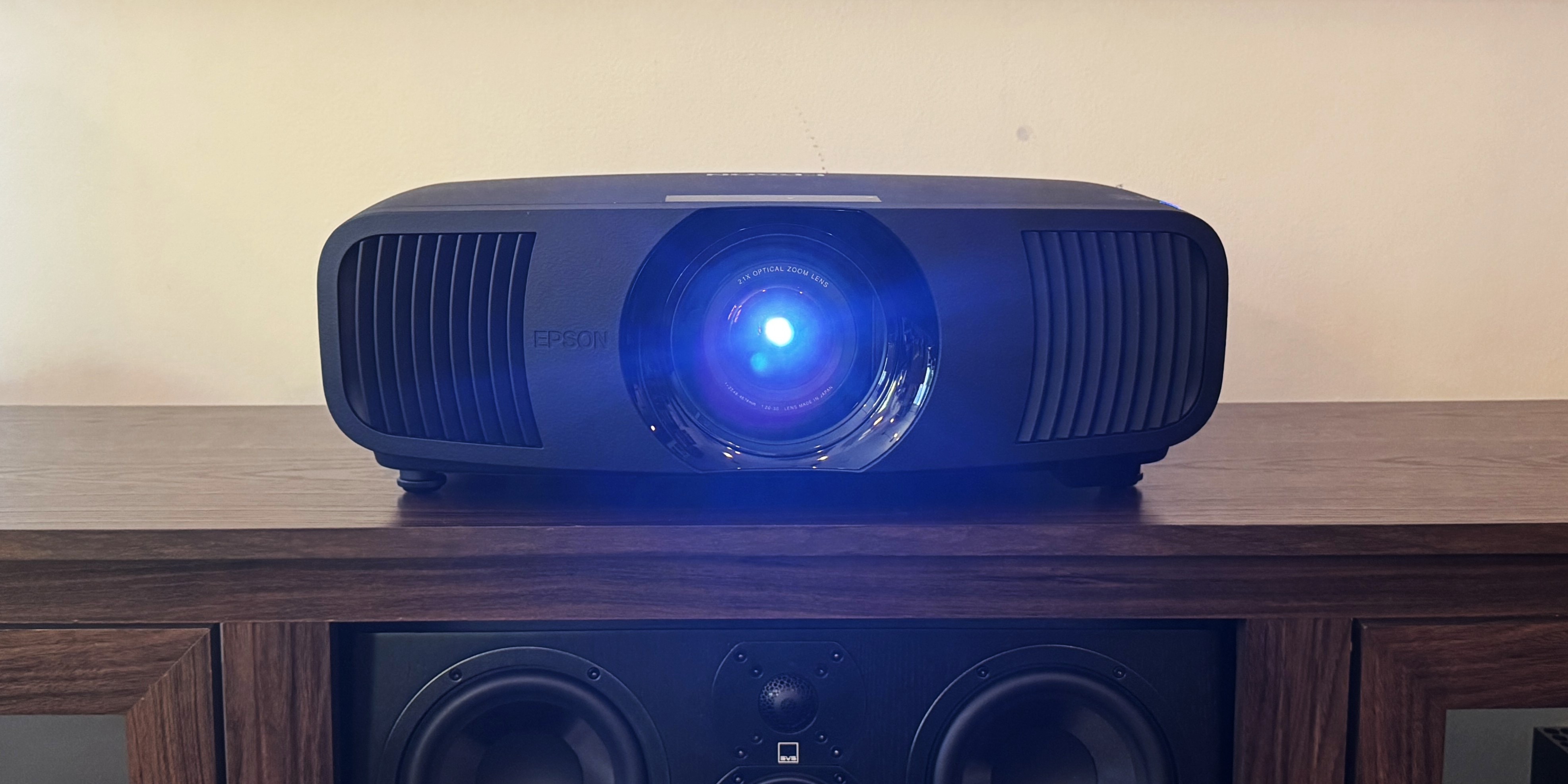TechRadar Verdict
The Epson Pro Cinema LS9000 is a new option for those looking for a lower-cost projector that still delivers an incredibly satisfying home theater experience. The brightness is less than you’ll get from more expensive projectors, and it lacks the dynamic tone mapping found on higher-end models, but beyond that, the LS9000 is an excellent performer that’s sure to satisfy.
Pros
- +
Great color accuracy in Natural picture mode
- +
HDR10+ support
- +
4K 120Hz support with low input lag for gaming
Cons
- -
No dynamic tone mapping
- -
No 3D support
- -
No Auto Low Latency Mode
Why you can trust TechRadar
Epson Pro Cinema LS9000: One minute review
The Epson Pro Cinema LS9000 is the latest, and least expensive, member of Epson's LS series of projectors. At $3,999 / £2,999 / AU$7,299, this entry-level dedicated home theater projector is notably cheaper than comparable options from JVC and Sony, yet still comes with a bevy of great features and performance to match.
Epson’s Pro Cinema LS9000 follows in the footsteps of the Epson LS12000 model that currently sits a the top of TechRadar’s Best Projectors list. The Epson Pro Cinema LS9000 aims to continue this excellence, employing the same 15-element glass VRX lens structure, laser light engine, and 3LCD technology as the LS12000.
Similar to the step-up LS12000, the Pro Cinema LS9000 supports 4K 120Hz signals, has relatively low input lag for gaming, and is compatible with the HDR10+ high dynamic range format. Its motorized lens shift, zoom, and focus make setup adjustments easy, and out of the box in Natural picture mode, it delivers accurate colors and a crisp image.
Even with all the great inclusions, some missing features reflect the LS9000’s entry-level status. The most glaring is a lack of dynamic tone mapping, which is also missing from the other LS series projectors that were originally released a few years ago, but is starting to show up in some less expensive home theater models. With a rated 2,200 lumens brightness (white and color), it’s also best suited for a home theater room with decent ambient light control, as opposed to a multi-purpose living space with light streaming in through windows.
Still, the Epson Pro Cinema LS9000 offers incredible performance for the price. It’s a solid projector that’s easy to set up, but still offers the ability to tweak and play with image settings that a new (or frugal) home projection enthusiast is sure to love.
Epson Pro Cinema LS9000 review: Price & release date
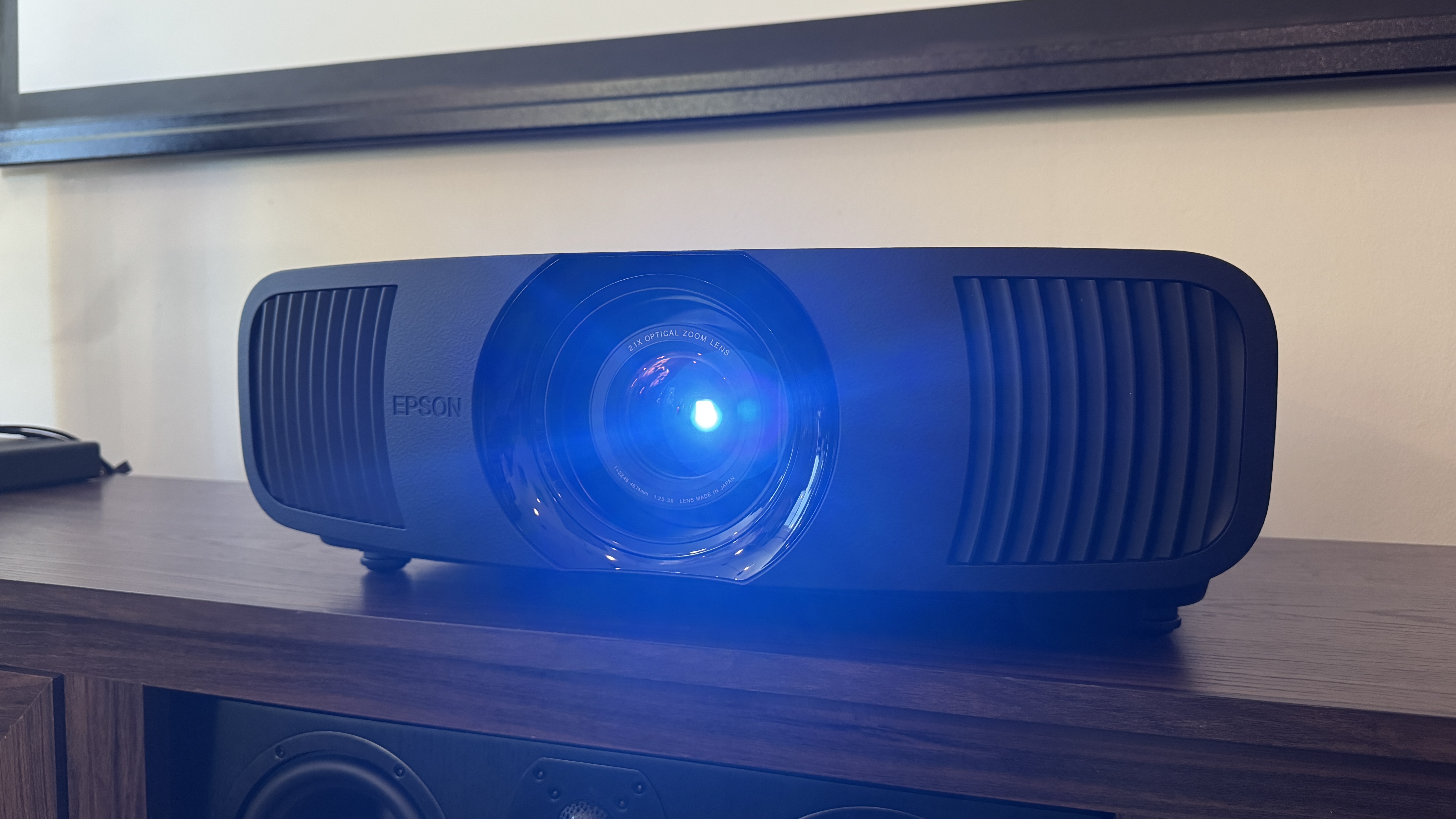
- Release date: July 2025
- Price: $3,999 / £2,999 / AU$7,299
The Epson Pro Cinema LS9000 made its debut in July 2025 at the Audio Advice Live show in Raleigh, North Carolina. It’s the least expensive of Epson’s Pro Cinema laser projectors, coming in at $3,999 / £2,999 / AU$7,299. For comparison, the Home Cinema LS11000 retails for $4,499 (up from $3,999 when released) and the LS12000 now goes for $5,999 (up from $4,999 at release).
Epson Pro Cinema LS9000 review: Specs
Screen sizes supported: | 50-300 inches |
Brightness (specified): | 2,200 Lumens |
HDR support: | HDR10, HDR10+, HLG |
Optical technology: | 3LCD laser diode |
Smart TV: | N/A |
Connections: | 2x HDMI 2.1 (one with eARC), 2x USB-A (one 300mA for optical HDMI power, one 5V/2A for power and firmware), Mini USB (service), RJ45 (control), RS-232c, 3.5mm (12V trigger) |
Dimensions (H x W x D): | 7.6 x 20.5 x 17.6 inches (193 x 520 x 447mm) |
Weight: | 28 pounds (12.7kg) |
Epson Pro Cinema LS9000 review: Design & features
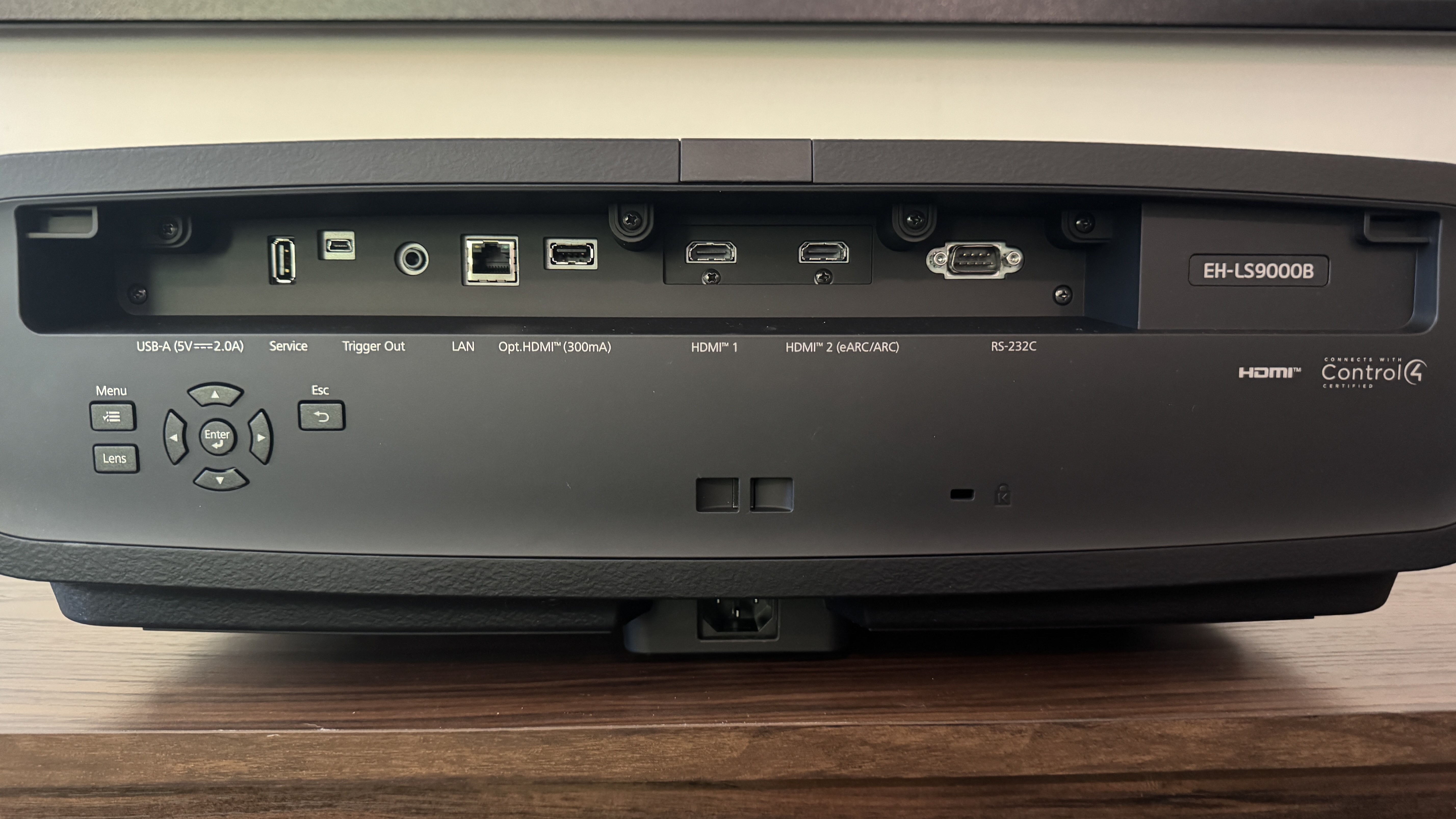
- Motorized zoom, focus, and lens shift
- 4K 120Hz support
- Motorized lens cover
The Epson Pro Cinema LS9000 shares the same look as its bigger siblings, the Pro Cinema LS12000 and Home Cinema LS11000, and the high-lumen Epson QB1000 released in late 2024. The chassis is large and a bit heavy (the Sony Bravia Projector 7 weighs less, but the JVC DLA-NZ5 weighs a little more), but I find the design and its black color to look sleeker than its heft lets on. All connections are on the back panel alongside touch controls if the remote is misplaced.
Sign up for breaking news, reviews, opinion, top tech deals, and more.
The look is not where the similarities to the LS11000 and LS12000 end. Inside, the LS9000 uses the same VRX lens with a 15-element glass structure and has Epson’s 4K 3LCD design architecture with three 0.74-inch LCD panels.
As is the case with all Epson projectors, the LS9000 uses pixel-shifting technology to achieve a 4K resolution from 1080p chips. Some enthusiasts complain about this not being “True 4K” and as lesser than the use of native 4K chips, but the 4K image from the LS9000 (and every other Epson that uses pixel-shifting technology) is detailed and crisp, especially from a normal viewing distance. The chip also allows for a maximum refresh rate of 120Hz.
The laser light source is specified for 2,200 lumens of both color (IDMS rated) and white (ISO rated) light output and has up to 20,000 hours of life in all modes. This is where the LS9000’s performance separates from the LS11000 and LS12000, which are rated at 2,500 and 2,700 lumens, respectively, and partially accounts for the difference in pricing. The blue laser diode array emits light through a fixed yellow phosphor (first released with the LS12000), as opposed to a phosphor wheel, to create white light, and the laser light source and fixed phosphor allow it to run silently.
The lower lumen output makes the LS9000 more suitable for a dark room – or at the very least, a light-controlled room — than the more expensive, higher light output projectors. But as I’ll discuss below, it still delivers enough brightness for daytime viewing.
There’s a generous +/- 24% horizontal and +/- 96% vertical powered lens shift on the LS9000, along with powered zoom (a ratio of 1-1.2) and focus that can be controlled from the remote to make setup adjustments easy. The projector’s throw ratio is 1.35-2.84:1. There’s also vertical and horizontal keystone correction (+/- 30 degrees), but with the amount of lens shift available, keystone correction likely won’t be necessary (and should always be avoided, if possible, as it can negatively affect the picture).
The LS9000 is compatible with an anamorphic lens kit (sold separately) and third-party options. A memory feature allows you to save image adjustments and lens positioning for different aspect ratio setups, and the lens is also protected by a motorized lens cover that opens and closes with the power cycle.
The LS9000 supports HDR10, HLG, and HDR10+ high dynamic range, and has two HDMI 2.1 inputs that support 4K 120Hz. While that’s great news for gamers, the projector doesn’t support ALLM, so you’ll need to manually switch the image processing from Fine to Fast for the lowest input lag. HDMI2 also supports eARC, so if you decide to connect a streaming stick directly to the projector, you can send out audio including Dolby Atmos, Dolby TrueHD, DTS Master Audio, and DTS:X formats.
One thing missing from the Epson Pro Cinema LS9000 is dynamic HDR tone mapping. Instead, there’s an HDR Dynamic Range slider that allows you to manually adjust the brightness of the HDR image.
The projector’s remote is a bit chunky, but the keypad is backlit and has all the necessary buttons to make easy adjustments while viewing. There are dedicated buttons to call up features like Fine/Fast (for gaming), different lens memory positions, signal information, lens adjustment, and color modes.
- Design & features score: 4.5/5
Epson Pro Cinema LS9000 review: Picture quality
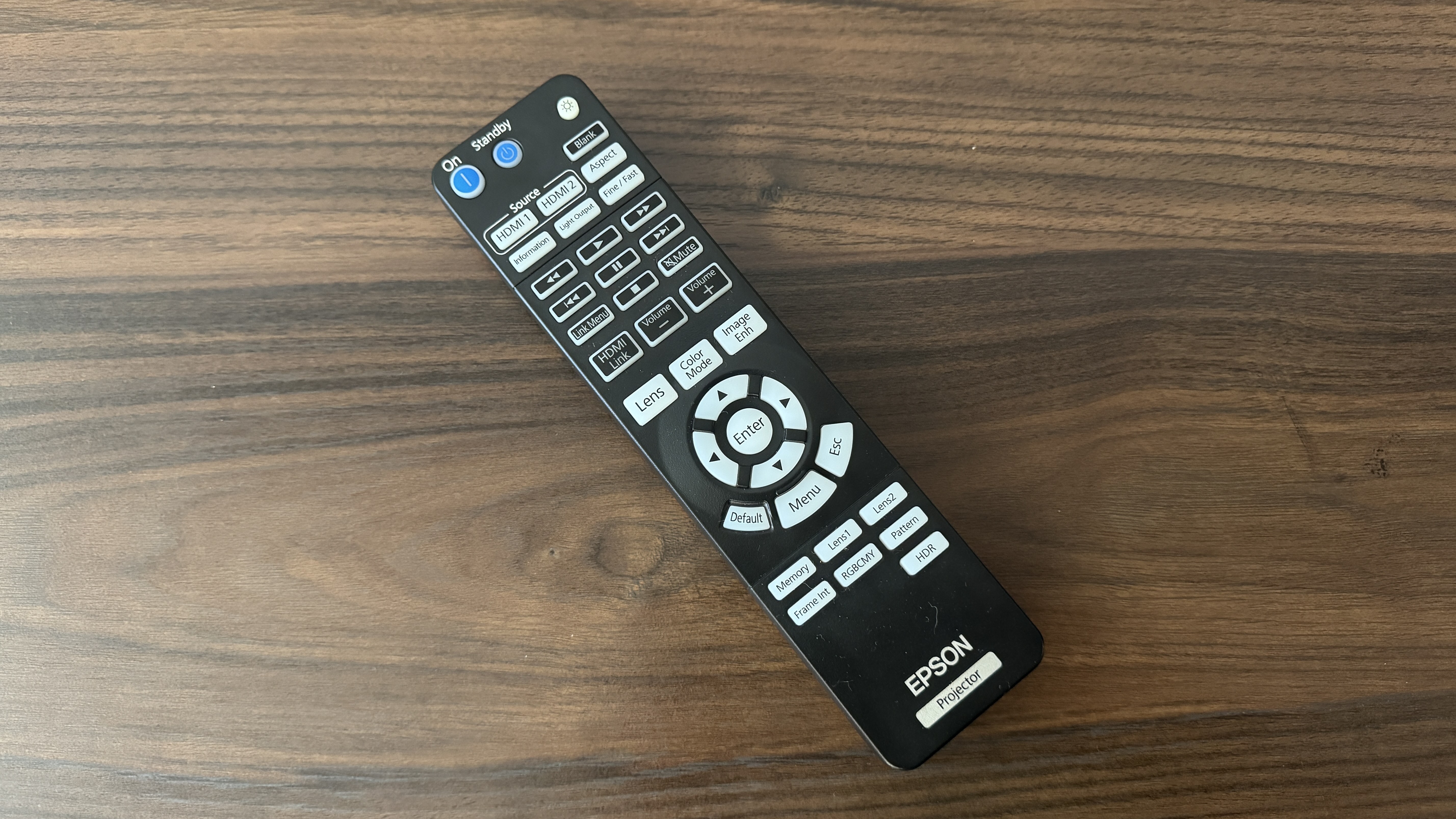
- Accurate image in Natural picture mode
- HDR10+ support
- No dynamic tone mapping
The LS9000 has five different picture modes — Dynamic, Vivid, Bright Cinema, Cinema, and Natural — and they are the same for both standard and high dynamic range sources. Each mode produces a watchable image out of the box, although all of them have some degree of blue tint to the grayscale, with Natural being the most accurate choice for both SDR and HDR.
The default color temperature setting of 6500K is still slightly on the blue side, but switching it to 6000K causes the color temperature to be a little too red. If you choose to do a professional calibration, you can use two different picture modes – one for SDR and one for HDR – and save them with the Image Memory setting.
Out of the box SDR measurements in Natural picture mode had an average Delta E of 2.8, with some grayscale reaching above 4 because of the blue bias. A calibration can get all dE down below 2.1, with many under 1. UHDA-P3 color gamut coverage measured 90.25%, while BT.2020 came in at 66.86%.
Brightness in Dynamic mode with my unit was 2,062 lumens, but that’s still within the measurement tolerance of ISO lumens, and due to the positioning of my projector, the image was zoomed in a bit, which causes the brightness to come down. It’s enough brightness for a watchable image in a room with ambient light (even with Natural picture mode, which is visibly less bright than other modes), but there’s a loss of shadow detail due to the light reflecting on the screen.
Where the projector really excels is when the lights are off. Colors look accurate and inviting, detail in both SDR and HDR is sharp, and the projector exhibits great contrast and shadow detail with the Dynamic Contrast setting at High Speed. The contrast isn’t as impressive as on the LS12000, which I evaluated a few years ago, but for the price, the LS9000 does an excellent job.
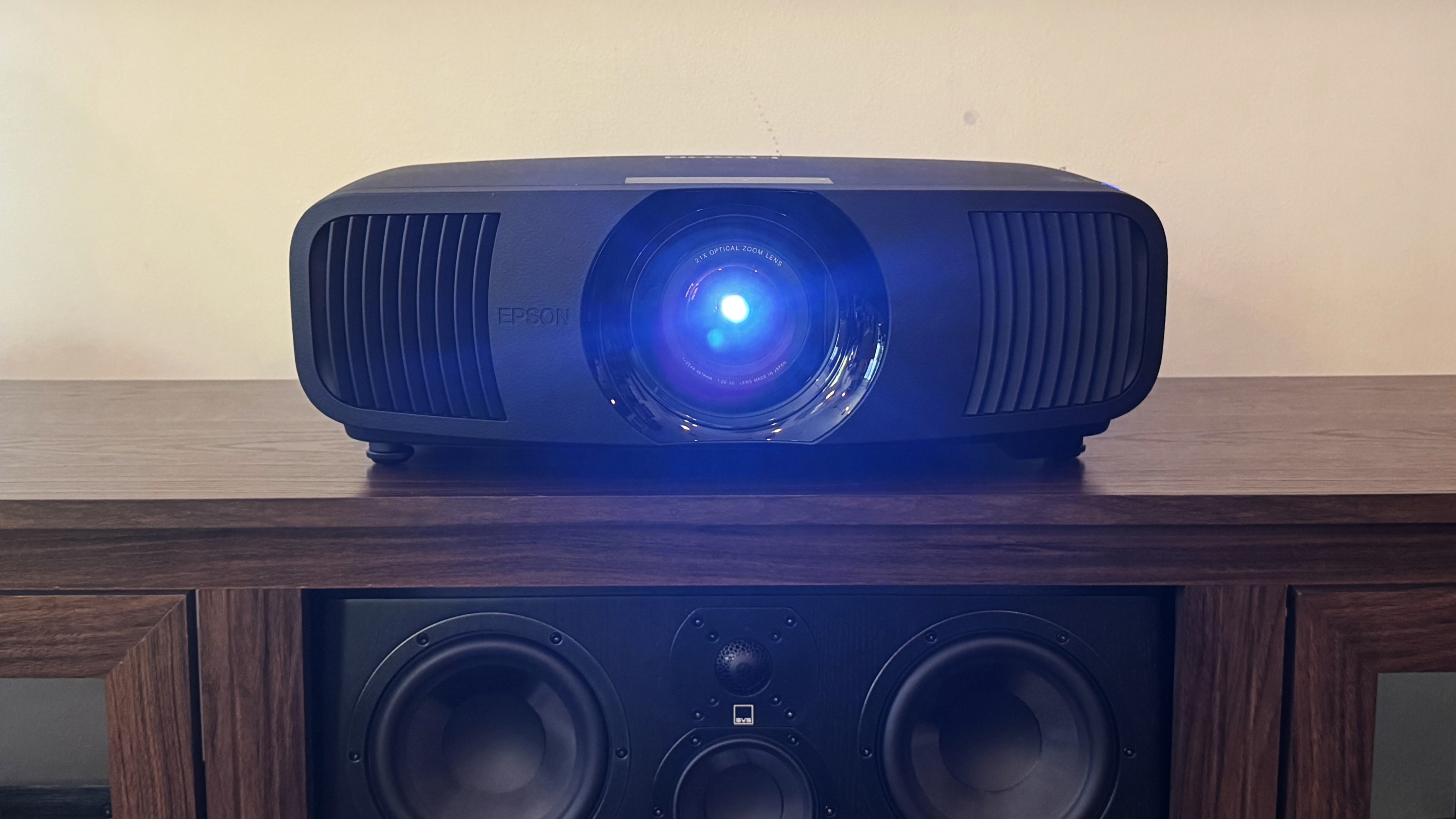
The HDR image does require some tweaking at times. Occasionally, bright highlights can cause some clipping — such as when the shark cage is lowered into the water in The Meg, and we can see the bright sun refracting through the ocean water. In this instance, I adjusted the dynamic range slider from its default of 8 to 10 (which slightly backs off the scene brightness).
Through most of my viewing, I played around with the slider, not just to address high brightness clipping, but also to see its effect on image depth. Generally, I found myself setting it between 8 and 10, with the Battle of Pelennor Fields in Return of the King at 8 and day scenes during Mad Max: Fury Road at a 9 for a bit more depth. None of the adjustments were life-altering, and I wouldn’t suggest changing the dynamic range slider mid-movie, but you’ll learn your preferences. This is where dynamic tone mapping is missed.
Home theater projectors have historically struggled to provide input lag low enough for gaming, but with two HDMI 2.1 ports that are capable of 4K 120Hz, the LS9000 is screaming to be used as a gaming projector. The Image Processing menu allows you to select a setting of Fine or Fast (which provides a lower input lag). With the Fast setting and a 4K 60Hz signal, the lag measured at 20ms (it’s 44ms with the Fine setting). Unfortunately, there’s no ALLM (Auto Low Latency Mode), so you’ll need to manually switch the setting when you game or watch content.
Input lag is low enough on the LS9000 to satisfy a non-competitive gamer (my son still enjoyed his time playing Minecraft). During my second playthough of Clair Obscur: Expedition 33, which relies on dodge and parry reactions during combat, I was able to still make it through combat without issue. Someone who regularly plays first-person shooter games will likely feel a difference between the LS9000 and one of the best gaming TVs, but for the vast majority of us, the Epson will deliver a great gaming experience.
- Picture quality score: 4.5/5
Epson Pro Cinema LS9000 review: Value

- Great performance for the price
- Solid gaming projector
- Missing an important home theater feature
The Epson Pro Cinema LS9000 is not only the least expensive model in the LS series, it’s one of the most affordable premium home theater projectors – the JVC DLA-NP5, which is a lamp-based model, retails for $6,000, as does the Sony VPL-XW5000ES, which came out three years ago.
Not only is the LS9000 brighter than both of those projectors, it also has a collection of features neither of them has, including a high-quality laser light engine, HDMI 2.1 ports with 4K/120Hz and eARC support, an excellent lens with motorized adjustments and lens cover, zoom and image memory, and 2,200 lumens of brightness.
There are still some compromises that must be made. Its biggest flaw is a lack of dynamic tone mapping, which we’re seeing in projectors half the price of the LS9000, like the Valerion VisionMaster Pro2. The LS9000 also doesn’t have 3D support, isn’t as bright as the step-up options from Epson, and is missing ALLM for gaming. But even so, the projector delivers a detailed picture with accurate color, which looks very engaging in a dark room. Also, the 20ms input lag time and 4K 120Hz support make gaming a joy on the big screen.
- Value score: 4/5
Should I buy the Epson Pro Cinema LS9000?
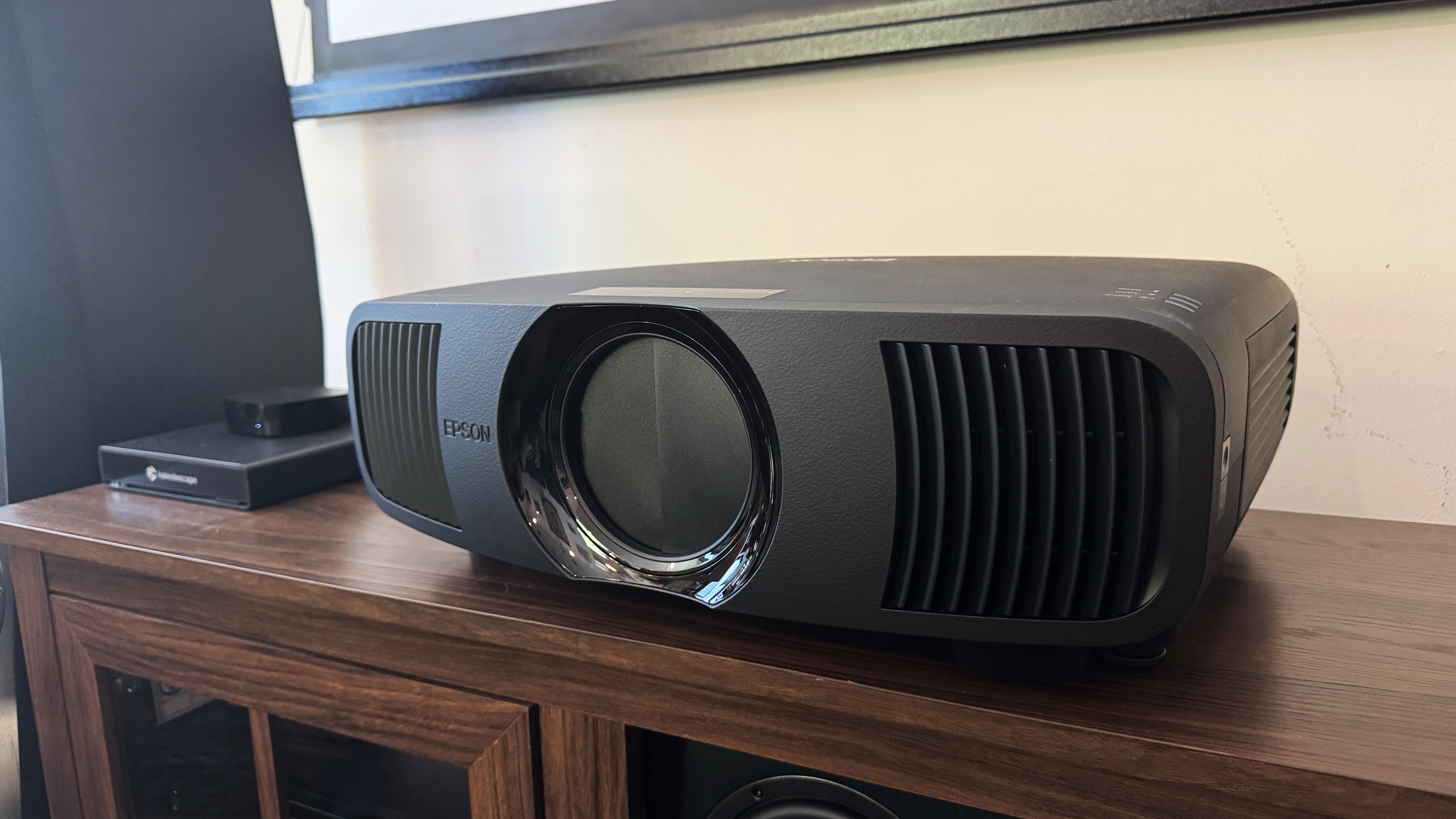
Attributes | Notes | Rating |
|---|---|---|
Design and features | Motorized zoom, focus, and lens shift, along with 4K 120Hz and HDR10+ support | 4.5/5 |
Picture quality | Accurate color in Natural mode, along with solid contrast, fine 4K picture detail, and low input lag for gaming | 4.5/5 |
Value | A very good value compared to other 4K home theater projectors, most of which cost several thousands more | 4/5 |
Buy it if...
You’re building your first serious home theater
If you’re making the jump from a basic projector to one truly designed for a 4K home theater, the LS9000 delivers an incredibly pleasing picture that rivals home theater offerings from JVC and Sony.
You also want a great gaming experience
It might not have ALLM, but the Pro Cinema LS9000 supports 4K 120Hz, and its input lag is low enough for all but the most competitive gamers.
You want HDR10+ support
Since the LS9000 doesn’t have dynamic tone mapping, watching HDR10+ content (with its dynamic metadata) will deliver the best dynamic content.
Don't buy it if...
You want dynamic HDR tone mapping
The LS9000, like its bigger siblings, doesn’t support dynamic tone mapping, instead relying on a manual dynamic range slider to adjust the HDR image.
You plan on watching with lots of ambient light
While 2,200 lumens is a good brightness spec, ambient light causes the image to look a bit washed out, which makes seeing shadow detail difficult.
Watching 3D movies is a priority
3D isn’t supported by the Epson Pro Cinema LS9000 (or by the LS11000 and LS12000), so you’ll need to look elsewhere for your 3D fix.
Also consider
| Header Cell - Column 0 | Epson Pro Cinema LS9000 | Epson Pro Cinema LS12000 | JVC DLA-NZ700 | Sony Bravia Projector 7 |
|---|---|---|---|---|
Price: | $3,999 | $4,999 | $8.999 | $9,999 |
Screen sizes supported: | 50-300 inches | 50 to 130 inches | 30 to 150 inches | 90 to 130 inches |
Brightness (specified): | 2,200 lumens | 2,500 lumens | 2,300 lumens | 2,200 lumens |
HDR support | HDR10, HDR10+, HLG | HDR10, HDR10+, HLG | HDR10, HDR10+, HLG | HDR10, HLG |
Optical technology: | Laser 3LCD | Laser 3LCD | Laser D-ILA | Laser SXRD |
Smart TV: | n/a | n/a | n/a | n/a |
Connections: | 2x HDMI 2.1 (1 with eARC) | 2x HDMI 2.1 (1 with eARC) | 2x HDMI 2.0 | 2x HDMI 2.1 |
Epson LS12000
<p>The LS12000 is the step-up model in Epson's Pro Cinema projector lineup. Rated for 2,700 lumens, it has a brighter picture than the LS9000 and also supports HDR10+ high dynamic range and a 4K 120Hz refresh rate for gaming. Other than brightness, the LS9000 and LS12000 are mostly similar when it comes to features and performance.<p><strong>Read our <a href="https://www.techradar.com/reviews/epson-pro-cinema-ls12000-projector-review"><strong>Epson LS12000 reviewJVC DLA-NZ700
<p>The JVC DLA-N700 is a big jump up in price over the LS9000, and it lacks Epson's 4K 120Hz support. At a rated 2,300 lumens, brightness is about the same, but the JVC features a native 4K display chipset and sophisticated dynamic HDR tone mapping to augment its HDR10+ high dynamic range support.<p><strong>Read our <a href="https://www.techradar.com/televisions/projectors/jvc-dla-nz700-review"><strong>JVC DLA-NZ700 review<strong>Sony Bravia Projector 7
<p>Like the JVC DLA-N700, Sony's entry-level projector is a big step up in price over the Epson, costing around $10,000. Its brightness spec is the same 2.200 lumens and it lacks the Epson's HDR10+ support. What you are getting with the Sony is 4K 120Hz and ALLM support for gaming, along with a native 4K display. It also has dynamic HDR tone mapping and Sony’s XR Processor for projector, which improves detail and clarity of images blown up to a cinematic size.<p><strong>Read our <a href="https://www.techradar.com/televisions/projectors/i-tested-the-sony-bravia-projector-7-and-it-has-the-deepest-blacks-ive-seen-on-a-4k-projector"><strong>Sony Bravia Projector 7 reviewHow I tested the Epson Pro Cinema LS9000
- Evaluated under various viewing conditions
- Measured and calibrated with professional software and hardware
- I am ISF-certified and have years of experience reviewing projectors
The Epson LS9000 laser projector was connected to my ceiling mount, approximately 11 feet from an Elite Screens CineTension 3 ISF-certified CineWhite screen. Using the Epson’s zoom and lens adjustment controls, the image was adjusted to fit the 100-inch diagonal screen.
I watched a wide range of content with both ambient light from the sun and ceiling lighting during the day and a dark, light-controlled environment at night. Movies and TV shows were streamed with an Apple TV 4K from the Disney+, HBO Max, and Hulu apps. I also used a Kaleidescape Strato V for high-quality movie playback, along with 4K Blu-ray discs played on an Oppo UDP-203 disc player. Games were played on an Xbox Series X.
For objective measurement testing, I used an X-rite i1 Pro 3 spectrophotometer, Murideo Seven-G 8K pattern generator, Konica Minolta LS-100 luminance meter, and Calman calibration software by Portrait Displays. Input lag tests were made with a Leo Bodnar 4K lag tester.
I’ve been testing projectors and other displays for a couple of decades, and am an ISF Level III certified calibrator.
- First reviewed: November 2025
- Read TechRadar's review guarantee
John Higgins got his start in 2003 at Home Theater Magazine working in its testing lab while writing reviews on speakers, TVs, universal remote controls, HTPCs, and other various bits of AV tech. Over the following decades, he's written for Sound & Vision, the New York Times' Wirecutter, IGN, T3, Projector Central, and Channel Guide Magazine as a tech columnist. Starting in 2022, John worked for Reviewed, eventually as the tech managing editor, before moving to Digital Trends to lead the AV section as its senior editor until April 2025. He is also an ISF Level III-certified display calibrator.
When not working as a tech journalist, John is a professional musician and music teacher, having received his master of music in collaborative piano from the University of Southern California.
You must confirm your public display name before commenting
Please logout and then login again, you will then be prompted to enter your display name.
